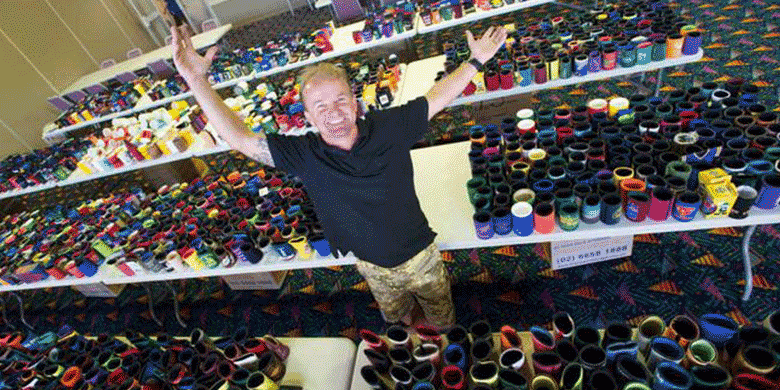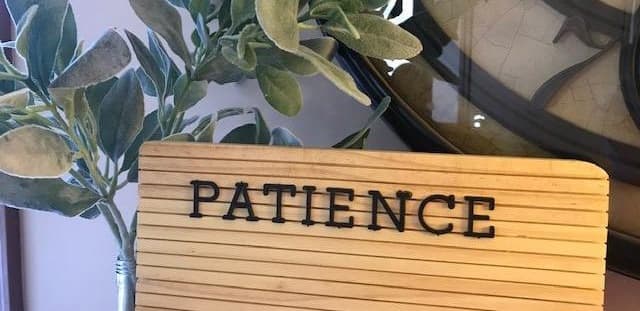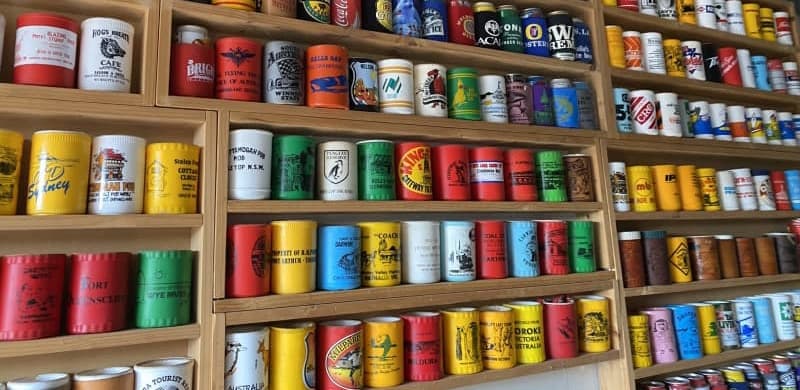
14 March, 2024
The Ultimate Guide to Collecting Vintage Stubby Holders
For those uninitiated, stubby holders – or beer koozies, as they're known in some parts – are those nifty little sleeves that keep your drink cold and your hands dry. But for many, they're more than just a practical item; they're collectibles, each with its own story and a slice of history.
The Allure of Vintage Stubby Holders
Collecting vintage stubby holders is much more than just amassing a bunch of old drink insulators. It's about capturing and preserving slices of history, each with its own unique story and character.
Historical Significance: Vintage stubby holders often reflect the cultural and social trends of their times. For instance, one from the 1980s might feature bold, neon colours and graphics that instantly transport you back to that decade. Collecting these items is like having a tangible piece of history, offering a glimpse into the past and how people lived, celebrated, and enjoyed their leisure time.
Representative of Places and Events: Many are souvenirs from iconic locations or significant events. They might commemorate a landmark sporting event, a famous concert, or a local festival. Owning these is like holding a memento that tells a story of a specific place or a momentous occasion.
Brand Memorabilia: They often bear logos or slogans of various brands, especially beer and soft drink companies. For fans of these brands, collecting vintage holders is a way to connect with the brand's history and evolution. Some collectors might focus on a specific brand, tracing its advertising journey through the years via them.
Artistic and Design Value: The design aspect is a huge draw. The artwork, typography, and overall style reflect the design trends of the era they were produced in. For those who appreciate retro art and design, these ones are miniature canvases showcasing styles that might no longer be in vogue but have an enduring appeal.
Nostalgia and Personal Memories: For many, they evoke personal memories. It could be one from a favourite pub you used to visit, a reminder of backyard barbecues with family, or a souvenir from a memorable road trip. These items become repositories of personal history and sentiment.
The Rarity and Thrill of the Hunt: Part of the allure is also in the rarity of these items. Finding one in good condition can be thrilling. The hunt itself – whether rummaging through op shops, scrolling online listings, or exploring collector fairs – is an adventure, adding to the excitement and satisfaction of the hobby.
Community and Sharing Stories: Collecting them also opens up opportunities to join a community of like-minded individuals. It's a hobby that allows you to connect, share stories, and learn from fellow collectors, creating a sense of camaraderie and shared passion.
Getting Started with Your Collection

1. Identifying Your Niche
When you start collecting, it's easy to be overwhelmed by the sheer variety out there. That's why finding your niche is essential.
- By Era: If you're a fan of a particular time period, like the vibrant '70s or the eclectic '80s, focus on ones from that era. Each decade has its unique style – be it the psychedelic patterns of the '70s or the neon and pastel shades of the '80s.
- By Brand or Brewery: For beer enthusiasts, collecting ones from different breweries, especially those that are defunct or have historical significance, can be fascinating. Each brewery has its own story, and their stubby holders often reflect their branding journey.
- Geographic Focus: Maybe you want to collect ones from different parts of Australia or the world. This approach can showcase a wide variety of designs and styles specific to different regions.
- Event-Specific: Some collectors focus on ones released for special events, like sports tournaments, concerts, or festivals. These often have unique designs and are linked to memorable moments in history.
2. Learning the History
Understanding the background and evolution of stubby holders not only adds depth to your collection but also enhances the overall experience.
- Origins: Start by learning when and why they were first created. This might involve delving into the history of beverage containers and how changes in materials and designs led to the need for them.
- Design Evolution: Look at how the designs have changed over the years. This can include changes in materials, shapes, and printing technologies. Notice how cultural trends, advertising styles, and consumer preferences have influenced these designs.
- Defining 'Vintage': In the world of collectibles, 'vintage' can have various meanings. Generally, an item that's 20 to 30 years old may be considered vintage. However, in the context of stubby holders, 'vintage' might also refer to the rarity, design style, or the story behind the item.
- Notable Manufacturers and Designers: Some might be sought after because of who made or designed them. Learning about notable manufacturers and designers can add an interesting layer to your collection.
Where to Find Vintage Stubby Holders
1. Op Shops and Garage Sales
These are often the treasure troves for collectors. The joy of sifting through items at a local op shop or a neighbourhood garage sale is unparalleled. You never know when you might stumble upon a rare one with a unique story or a classic design.
Tips: Visit these places regularly, as their stock can change frequently. Always be ready to dig in and look through everything – the best finds are often hidden.
2. Online Marketplaces
Websites like eBay, Gumtree, or even Facebook Marketplace can be excellent resources for finding specific types. Whether you're looking for a particular brand, era, or design, these platforms offer a wide selection.
Tips: Set up alerts for specific searches so you can be notified when new items are listed. Check the seller's ratings and reviews for authenticity and reliability.
3. Collectors' Fairs and Swap Meets
Attending these events is not only about finding items; it’s also about immersing yourself in the collector’s community. You'll meet fellow enthusiasts, exchange stories, and learn from their experiences.
Tips: Prepare to network. Bring along your own duplicates or less desired items for potential trades. These events are often about making connections as much as they are about the items themselves.
4. Estate Sales
Estate sales can be a goldmine for rare and vintage ones. Sometimes, entire collections are put up for sale, giving you a chance to acquire unique pieces.
Tips: Get there early for the best selection. Estate sales are usually advertised in local newspapers or online, so keep an eye out for listings in your area.
Making the Most of Your Search

Be Informed: Know what you’re looking for. Being knowledgeable about different styles, eras, and brands will help you spot a good find.
Patience is Key: The hunt for the perfect one can take time. Enjoy the process and don’t get discouraged if you don’t find something immediately.
Network: Talk to other collectors, join online forums, and engage in social media groups dedicated to stubby holder collecting. Networking can lead to tips about sales or unseen items.
Stay Organised: Keep track of where and when you find items to identify patterns, like the best times to visit certain shops or sales.
Finding them is a thrilling part of the collecting journey. Each place offers a different experience and potential for discovery. Whether it’s the thrill of finding a rare item at an estate sale or the joy of a serendipitous find at an op shop, each adds to the rich tapestry of your collection
Assessing the Value and Authenticity
1. Condition is Key
The condition of it plays a major role in determining its value. Collectors typically look for items in the best possible condition.
- What to Look For: Vibrant colours that haven't faded with time, minimal wear and tear, and seams that are intact and not fraying. If it still retains its original shape without much deformation, that’s a plus.
- Consider the Age: Remember that some wear might be acceptable, especially for very old items. It’s about finding a balance between age and condition.
- Restoration: Sometimes, light cleaning can help restore its appearance, but be cautious. Over-restoration can reduce its value.
2. Rarity
Ones that are rare, were produced in limited quantities, or were made for special events typically have higher value.
- Limited Editions and Promotions: Keep an eye out for custom stubby holders that were produced in limited numbers or for special occasions, like anniversaries of breweries or major sporting events.
- Discontinued Brands: Ones from brands that no longer exist can be particularly valuable, as they represent a piece of lost history.
- Unique Designs: Sometimes, a unique design, even if not particularly old, can be valuable due to its rarity or the artist behind it.
3. Authenticity
Ensuring it is authentic and not a reproduction is vital, especially when dealing with rare items.
- Research: Familiarise yourself with the hallmarks of genuine vintage stubby holders. This might include specific manufacturing techniques, materials used, or known designs from certain periods.
- Consult Experts: If in doubt, seek advice from experienced collectors or professionals. They can provide insights into the authenticity of a piece.
- Be Wary of Reproductions: Reproductions can sometimes be hard to spot. Check for signs like modern materials, printing techniques, or discrepancies in design when compared to known genuine items.
4. Tips for Authenticating
- Documentation: If one comes with a backstory or documentation, it can add to its authenticity.
- Provenance: Knowing the history of the item - where it came from and who owned it - can be helpful.
- Comparison: Compare with known authentic items, either online or through collector groups, to spot differences.
Preserving Your Collection

1. Storage
Proper storage is crucial to maintain the condition and longevity. Here’s what you should consider:
- Avoid Direct Sunlight: Sunlight can cause colours to fade over time. Store them in a place where they are not exposed to direct sunlight.
- Temperature-Controlled Environment: Extreme temperatures and humidity can damage materials. Aim to store your collection in a stable, temperature-controlled environment. This means avoiding damp basements or hot attics.
- Proper Shelving or Containers: Use shelves or containers that are clean and free from substances that might degrade the materials. Acid-free storage materials are a good choice.
2. Display
Displaying your collection can be as rewarding as the collection itself. It's a way to enjoy and share your items with others daily.
- Shelves and Shadow Boxes: These are great for display as they protect the items while showing them off. Shadow boxes, in particular, can offer a great view while keeping the holders dust-free and secure.
- Themed Displays: Organise your collection based on themes – it could be by era, colour, brand, or events. This not only makes for an attractive display but also tells a story.
- Rotating Displays: If you have a large collection, consider rotating items on display. This gives each piece its moment in the spotlight and reduces prolonged exposure to potential environmental damage.
3. Tips for Display and Preservation
- Avoid Handling: The more you handle them, the more likely they are to wear. When you do handle them, make sure your hands are clean and dry.
- Cleaning: If they need cleaning, do it gently. Often, a soft, dry cloth is enough to remove dust. Be cautious with liquids and chemicals.
- Insurance and Cataloguing: For particularly valuable collections, consider getting insurance. Keeping a detailed catalogue of your collection is also a good idea, both for insurance purposes and personal record-keeping.
Taking the time to properly store and display your collection not only preserves their condition but also enhances your enjoyment of them. A well-preserved and thoughtfully displayed collection can be a source of pride and joy, a centrepiece of your home, and a topic of conversation for visitors. Plus, it ensures that your cherished collection can be enjoyed for many years to come.
Joining the Community
1. Forums and Social Media Groups
The internet has made it easier than ever to connect with like-minded individuals who share your passion.
- Online Forums: Look for forums dedicated to vintage collectibles or specifically to stubby holders. These can be goldmines of information, offering insights from experienced collectors, identifying rare items, and tips on preserving your collection.
- Social Media Groups: Platforms like Facebook and Instagram have communities of collectors. Join these groups to share your finds, ask questions, and connect with others.
- Trade Opportunities: These platforms often facilitate trades, allowing you to diversify your collection and part with duplicates.
- Building Friendships: Perhaps one of the most rewarding aspects of joining these groups is the friendships you can form with people from all over the world who share your interest.
2. Collector Events
Attending events is a fantastic way to immerse yourself in the collector community.
- Meet-ups and Exhibitions: Look for local or national meet-ups and exhibitions. These events are great for seeing a wide range of collections, gaining new insights, and meeting fellow collectors in person.
- Fairs and Swap Meets: These events are not only for buying and trading but also for learning. You can find rare items, learn about the history of different ones, and get tips from seasoned collectors.
- Seminars and Talks: Sometimes, these events include talks from experts or seasoned collectors, which can provide deeper knowledge and context to your collecting journey.
3. Tips for Engaging with the Community
- Be Active: Don’t hesitate to ask questions, share your own experiences, and offer advice where you can.
- Respect and Learn: Every collector has a unique perspective. Respect different viewpoints and be open to learning from others.
- Networking: Build your network by actively participating in discussions and events. Remember, the next great addition to your collection might come from a tip from a fellow collector!
- Share Your Passion: Don’t be shy about sharing your enthusiasm and knowledge with others. It's a great way to inspire and be inspired.
Becoming part of the collecting community can significantly enhance your collecting experience. It's not just about acquiring new items; it's about sharing stories, learning, and building relationships with people who share your passion. Whether it’s online or in person, joining this community can add a whole new dimension to your hobby, making it more rewarding and enjoyable.
The Joy of Collecting

Part of the excitement in collecting comes from the search itself. Whether you're scouring through online listings, rummaging in op shops, or attending collectors' fairs, the anticipation of finding that next special piece is exhilarating. Each hunt is an adventure, filled with possibilities and surprises.
Every one has a story. It might be a relic from a historical event, a keepsake from a memorable advertising campaign, or a memento from a personal milestone. Collecting these items allows you to own and preserve a piece of history, offering a tangible connection to the past.
There's a profound sense of accomplishment in finding and securing a sought-after or rare stubby holder. Each addition to your collection represents effort, patience, and sometimes a bit of detective work. This personal investment makes each piece all the more valuable to you.
Displaying your collection is not just about aesthetics; it's about sharing your passion and the stories behind each piece. Whether you arrange them thematically or show off your rarest finds, your collection is a reflection of your journey as a collector.
A well-curated collection is bound to spark interest and conversation. Each holder can be a starting point for fascinating stories about history, design trends, or personal anecdotes.
Beyond their material value, they often evoke nostalgia and personal memories. They can transport you back to different times and places, making them cherished keepsakes as much as collectible items.
Collecting often introduces you to a community of like-minded individuals. Sharing experiences, knowledge, and stories with other collectors adds a rich, social dimension to the hobby.
So, whether you’re just starting out or you're an experienced collector, the world of vintage stubby holders is rich with history, diversity, and community. Happy collecting!
The Stubby Holders Team


